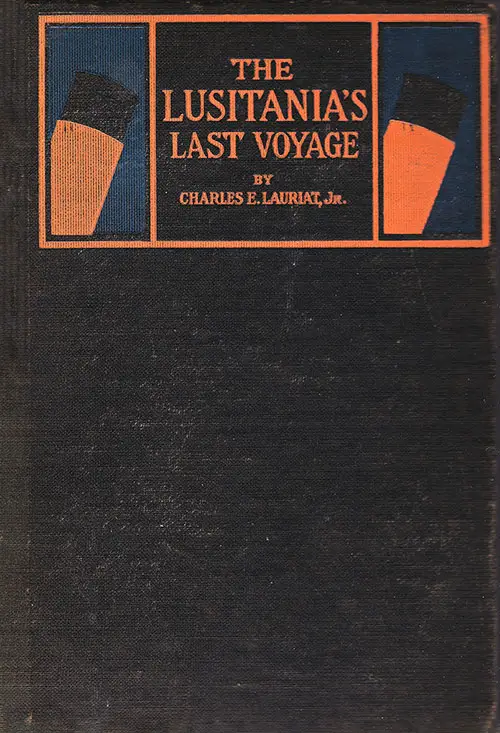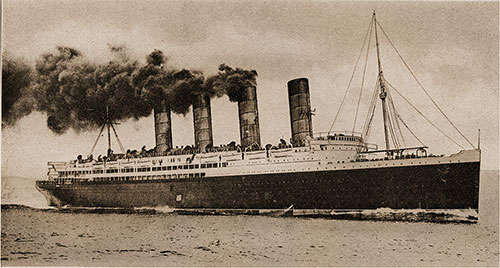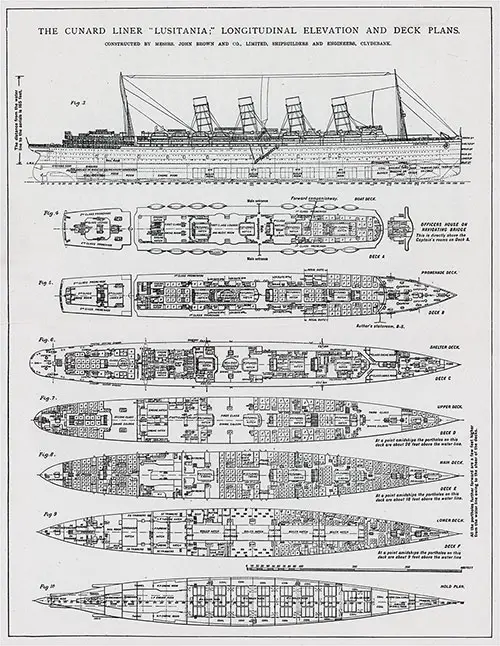The Lusitania's Last Voyage - 1915

Front Cover, The Lusitania's Last Voyage by Charles E. Lauriat, Jr., 1915. | GGA Image ID # 1812fce038
Synopsis
The Lusitania’s last voyage; being a narrative of the torpedoing and sinking of the R. M. S. Lusitania by a German submarine off the Irish coast May 7, 1915.

A German Submarine U-20 Fired Two Torpedoes Into the Side of the 32,000 Ton RMS Lusitania of the Cunard Line off Old Head of Kinsale on the Southern Irish Coast, Sinking the Ocean Liner on 7 May 1915. The Lusitania's Last Voyage, 1915. | GGA Image ID # 1813500026
Reviews
"Mr. Lauriat gives a simple, direct, and dignified account of his personal experiences on the great Cunarder during the frightful hours just before and following the final disaster. It is an interesting account of thrilling personal experiences told with fairness.”—Literary Digest.
"Consists of Mr. Lauriat's recollections dictated in London a few days after the accident; The account taken from the Frankfurter Zeitung, May 9, 1915, (original text and translation); The full report of the official inquiry held by Lord Mersey and his assessors; Points where the author's observation differed from these findings. The author is a son of C. E. Lauriat the publisher and bookseller." -- The Open Shelf (1916)
Mr. Lauriat tells with continuity of incident and clearness of detail of what happens from the moment the torpedo struck to his arrival in London.—Boston Transcript.
The Cunard Liner Lusitania Longitudinal Elevation and Deck Plans. Constructed by Messrs. John Brown and Co., Limited, Shipbuilders and Engineers, Clydebank. The Plans of the Lusitania Here Reproduced Are from "Engineering" (London) In the Issue for May 14th, 1915. They Are the Plans Originally Published in That Magazine When the Boat Was First to Put into Commission in 1907. The Arrangement and Number of the Lifeboats Were Changed a Few Years Back and Were Different from Those Shown in the Plan. On Her Last Voyage, There Were Eleven on Each Side, Slung Higher to Allow Space for the Collapsible Lifeboats That Rested on the Deck Under the Regular Lifeboats. Also, This Plan Does Not Show the Extra Collapsible Lifeboats Nested Out on the After Deck. The Launch That Is Indicated on the Plan, I Did Not See. The Lusitania's Last Voyage, 1915. | GGA Image ID # 1812db3742. Click for Larger Image.
The Lusitania's Last Voyage - A Review
A very clear-headed account of the Lusitania horror, as seen by a passenger of the ill-fated ship, has been published in Boston. It is entitled “The Lusitania's Last Voyage: Being a Narrative of the Torpedoing and Sinking of the R. M. S. Lusitania by a German Submarine Off the Irish Coast, May 7, 1915, by Charles E. Lauriat, Jr., One of the Survivors." (Houghton Mifflin Co. :$1).
Mr. Lauriat has little to say of German war methods, but vividly describes his own remarkable experience and sharply criticizes the officials of the Cunard Line for their inefficiency, he saw no panic among the passengers, but says the crew were inefficient and the captain foolishly forbade the lowering of the life boats until it was too late.
After helping in a last vain attempt to lower one of the starboard boats filled with women and children. Mr. Lauriat found himself in the water and was caught by one of the aerials of the wireless apparatus when the ship went down, but managed to kick himself free.
He found a collapsible life-boat, opened it up, and with the aid of others, rescued thirty-two people in that small craft.
One woman whom he lifted in was as black as coal, and nearly all her clothes had been torn from her, yet her witty talk cheered the others.
She had been sucked into one of the great smoke-stacks when the vessel sank, and had been blown out by the explosion that occurred when the cold water reached the boiler.
The author brings many serious charges against the officers and crew of the Lusitania. The most important is that the port-holes were left open as far down as Deck E, which negligence hastened the sinking of the vessel.
Mr. Lauriat says the vessel did not go down head first. hut rather settled along the whole water line. He also charges that the collapsible boats were not fitted with oars.
His testimony as to the discipline of the officers and crew is in sharp conflict with the finding of Lord Mersey’s court.
"The Lusitania's Last Voyage (Review)" in The Fortnightly Review, St. Louis: Arthur Preuss, Vol. XXIII, No. 2, 15 January 1916, p. 18.
Library of Congress Catalog Listing
- Personal name: Lauriat, Charles Emelius, Jr., 1874-1937.
- Main title: The Lusitania's last voyage : being a narrative of the torpedoing and sinking of the R. M. S. Lusitania by a German submarine off the Irish coast, May 7, 1915 / by Charles E. Lauriat, Jr., one of the survivors.
- Published/Created: Boston ; New York : Houghton Mifflin Company ; The Riverside Press Cambridge, 1915.
- Description: vii, 158 pages : illustrations ; 19 cm
- LC classification: D592.L8 L3
- LC Subjects: Lusitania (Steamship)
- LCCN: 15025328
- Geographic area code: n-us--- e-gx--- e-uk---
- Type of material: Book

